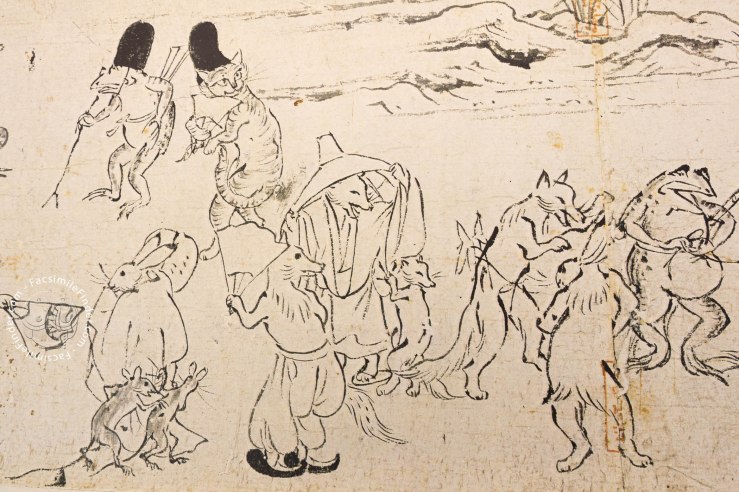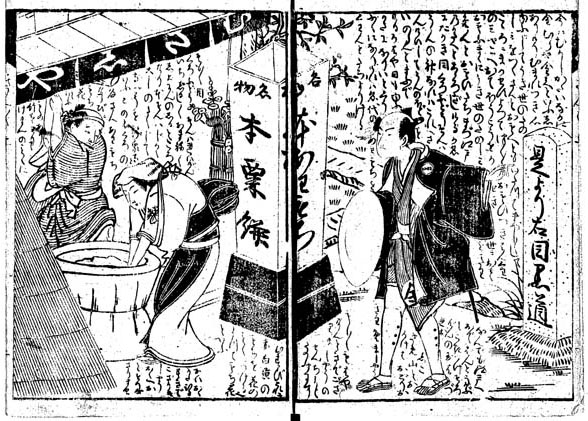The late 20th to 21st century was arguably the time period that gave rise to the unique styles and techniques most recognized in current day manga. It was the century that served as the transformative beginning of Japanese art during the Edo period and started an entirely new era that will be dedicated to the continuous evolution of a new form of art and entertainment, manga. Perhaps this is one of the reasons why many proponents have claimed that manga originated from this very time period. While the current style of manga truly did emerge from this era due to many influential factors, it must be noted that the concept of manga in Japan could be traced back to as far as the 12th century. Picture books, and drawings with text during the 12th to 19th century all embodied the general and broad idea of manga. The concept of manga starting from centuries back will eventually grow out into an art form that has and will continue to attract millions of fans internationally, and this is where we will start, centuries back in the page of history.

12th to 13th Century: The Scrolls of Frolicking Animals
The connections between 12th through 19th-century Japanese drawings and current-day manga has made it difficult for historians to pinpoint the exact time period of when manga is believed to have originated. With an ever-evolving Japanese art culture that has constantly adapted to a growing Japanese society, the changes, developments, and new innovations have all blurred together making it hard to draw a line between new art styles and genres. Despite this, it is found that what is needed to declare the beginning of a new form of Japanese art is the concept itself. Hence, countless historians have credited the Choju-jinbutsu-giga or The Scrolls of Frolicking Animals as one of the first and oldest manga drawings.
The Scrolls of Frolicking Animals is a collection of four scrolls created during the Heian Period and follows the Japanese tradition of being read or viewed in the order of right to left. This Japanese tradition is consistent and can be seen actively passed down among evolving Japanese art styles, from ukiyo-e art to the manga today.
Depicting drawings of frolicking forest animals often engaged in human-like activities, the scroll was created with the intention of criticizing Japanese priests by comparing them to monkeys, rabbits, and toads. The eloquent facial expressions, techniques used to amplify movement, and the linear monochrome drawing styles all perfectly captured the drawings in a way where it connects The Scrolls of Frolicking Animals to the manga drawing concept.
The Term “Manga”
The term “manga” can be interpreted in a variety of ways, and when defined by researcher Isao Shimizu who is the author of “Manga no Rekishi” (History of Manga) manga can be interpreted as works consumed on a large scale. Thus, according to Isao Shimizu, the title of Japan’s first manga would go to a book of drawings called, Toba Ehon, created during the Edo Period. Although Toba Ehon was considered the first manga, the term itself, “manga”, did not appear until 1798, where it was used to describe a picture book called, Shiji no Yukikai by Santō Kyōden. Later in 1814, it would also be used by an influential Japanese ukiyo-e artist named Katsushika Hokusai on the title of one of his works, Hokusai manga.
Over the centuries, the meaning and the use of the word “manga” has changed based on how the current society at the time perceive the word. As used by the ukiyo-e artist Hokusai during a time period where the word “manga” was considered unusual and rarely used, “manga” could be playfully translated as “brush running away with itself”. Technically, when defined by the interpretation of Hokusai, “manga” acts as a broad description of any Japanese artistic works that appear on paper or prints and was created for a mainstream audience. Up to the current day, some still view manga as a description, but in a different sense. They define manga as a description of how the content was produced to differentiate manga from other forms of artistic works and entertainment, such as anime. However, as supported by the New York Public Library, others view manga as an “umbrella term for a wide variety of comic books and graphic novels originally produced and published in Japan”.

Drawing from Toba Ehon 
Drawing from Shiji no Yukikai 
Drawing from Hokusai Manga 
Drawing of facial expressions from Hokusai Manga
Ukiyo-e
From 1630 to 1853, Japan went into seclusion and closed off its border to foreigners while also preventing its own people from leaving. This decision was due to the conversion of 500,000 Japanese to Catholics by European missionaries during the 16th to 17th century. The dynamics of Japanese politics at first favored the efforts of the European missionaries due to its political and economical advantages. However, following the Spaniard’s conquest of the Philippines, the current Japanese shogun at the time, Toyotomi Hideyoshi feared the motives of the Europeans behind their conversion of the Japanese. In the belief that their religion would be contaminated by foreign countries, Hideyoshi launched the anti-foreign, anti-Christian policy which later would be implemented by edicts issued through shogun Tokugawa Lemitsu that would essentially isolate Japan from the rest of the world.
Following Japan’s isolation was the Edo period, an era when the Japanese economy flourished alongside the cultivation of their own unique culture. It was during the Edo period when ukiyo-e was established within Japanese art culture under the influence of Yamato-e, a style of Japanese paintings that was developed in the Heian period. Ukiyo-e is both a style and a genre of Japanese painting and woodblock print that depicts drawings of the “common people” and could be translated as “pictures of the floating world”.
The flat nature of Japanese art is present in the art of ukiyo-e and carried on as a feature of manga. Despite using and innovating new techniques that would indicate perspective and divide the areas of foreground, middle-ground, and background, neither the artistic works of ukiyo-e nor manga were intended to create the illusion of three-dimensionality. Some have asserted that the style of ukiyo-e and manga are unrealistic. While that is accurate to a degree, realism was not intended to be found within the style in both the artistic works of ukiyo-e and manga, but rather within its content. And in many cases, content that ties in closely with the Japanese culture.
Furthermore, similar to ukiyo-e, manga are artistic works intended for the popular consumption of the mass population. The innovation of centuries-old woodblock text printing techniques created by ukiyo-e printmakers during the 17th century has made the widespread distribution of ukiyo-e art possible, similar to the quick production of manga today.
The characteristics carried on from centuries-old art styles to current day manga not only displayed the uniqueness of Japanese art but also the cultural heritage presented in every new and emerging form of art and entertainment in the Japanese culture.
Kusa-zōshi (草双紙)
Written in colloquial style and decorated with large-size illustrations, kusa-zōshi is a form of Japanese popular literature during the Edo and early Meiji period that covers various genres. Defined by the colors of their bindings, the genres of kusa-zōshi include, aka-hon (赤本), kuro-hon (黒本), aohon (青本), and kibyōshi (黄表紙).
Aka-hon (赤本), or “red books,” is considered the oldest form of woodblock-printed comic books, and compromised of contents that are less mature when compared to other kusa-zoshi, such as children’s tales, fairy tales, and folks legend. Featuring plentiful illustrations and simple yet entertaining plots, aka-hon is a genre that targeted young Japanese readership.
Kuro-hon (黒本), or “black book,” features an extensive range of content including revenge, loyalty, and martial stories, dramatic narrations, etc.
Ao-hon (青本), or “blue books,” re-told dramas from popular theatres and were almost indistinguishable from kuro-hon. What set the two genres apart was that ao-hon were divided into two distinct categories: works especially for the young or less literate individuals, and works that catered towards cultured adults.
Kibyōshi (黄表紙), or “yellow books,” were considered to be the first Japanese comic books written for adults with an emphasis on entertainment. This genre was the most popular of the four and has been widely distributed throughout Japan during the Edo period. Regarded as manga’s close ancestor, some kibyōshi featured komae or framed pictures to create certain effects within the plot of a story. Dialogue balloons and many of the techniques used to create expressions has also been carried on from kibyōshi to modern manga.
The development of genres in modern manga, from the content to the targeted demographic has a history that could be traced back to the different publications of kusa-zōshi. Moreover, not just limited to kusa-zoshi, almost all influential and cultural art movements of Japan similar to that of ukiyo-e have found themselves inevitably influencing modern manga. Simply said, manga is not solely a product of the modern era, but also a product of the centuries of Japanese artistic traditions that are deeply engraved within the Japanese culture.
References:
Jackson, J. F. (2014). A Study of Ukiyo-e’s Place in the Development of Modern Manga Through the Works of Rumiko Takahashi [PDF]. The University of Missouri-Kansas City. Retrieved from https://rb.gy/uumzwx
Bounthavy, P. (2020, August 05). How manga and anime are influenced by comics, Ukiyo-e, Art Nouveau. Retrieved December 23, 2020, from https://bounthavy.com/en/visual-influences-manga-comics-ukiyo-e-art-nouveau/
Bryce, M. (2017, July 17). Kibyōshi. Retrieved December 20, 2020, from https://professorlatinx.osu.edu/comics/kibyoshi/
Wikipedia. (2020, February 29). Kusazōshi. Retrieved December 20, 2020, from https://en.wikipedia.org/wiki/Kusaz%C5%8Dshi.




















Very informative post there Joey!!. A detailed look at how manga has evolved from its origins from the early centuries.
LikeLiked by 1 person
Thank you Mallow! 😀
LikeLiked by 1 person
Very interesting read!
LikeLiked by 1 person
very informative and helpful! thank you !
LikeLike